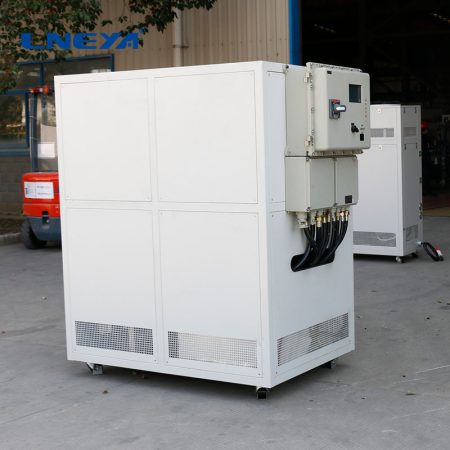Glycol Water Cooling System
Kontaktieren Sie uns noch heute für die perfekte Lösung zur Temperaturkontrolle
The glycol water cooling system is a chiller that uses ethylene glycol as the refrigerant.
Sometimes the cooling liquid needs to be below 0℃. If water is used for cooling, it will freeze. Adding some antifreeze liquid can avoid freezing, and ethylene glycol can prevent freezing.
In the all-air system, when the outdoor temperature is too low in winter, it is not easy to implement the air conditioning method of using cooling towers to directly provide cooling to the inner area. At this time, the outdoor cold air can be used as the cold source, ethylene glycol solution can be used as the refrigerant, and the outdoor natural cold source can be introduced indoors to provide cooling to the inner area.

Working principle of glycol water cooling system:
Install a plate heat exchanger outdoors, and a fan will introduce the outdoor cold air into the plate heat exchanger. The ethylene glycol solution and the outdoor cold air will exchange heat in the plate heat exchanger. The cooled ethylene glycol solution enters the air conditioning unit in the inner area, where it exchanges heat with the mixed air (air mixed with new and return air). The mixed air is cooled, and after the temperature drops, it enters the inner room and supplies the indoor air. District room cooling. The temperature of the ethylene glycol solution rises and returns to the outdoor plate heat exchanger again to exchange heat with the cold outdoor air. After the temperature drops, the cycle continues. This type of heat exchange is often used in heat recovery systems. Ethylene glycol exchanges heat with high-temperature exhaust air. After the temperature rises, it enters the fresh air cabinet to preheat the fresh air. Therefore, the heat in the exhaust air is recovered to heat the fresh air, saving electric energy and operating costs.
This method of using ethylene glycol solution as a secondary refrigerant to introduce the cold energy in the outdoor cold air to provide cooling to the inner area is a very energy-saving air conditioning method. Just install a plate heat exchanger outdoors. During operation, the chiller is turned off and only the fan and air conditioning unit are turned on to introduce natural cold sources to provide cooling to the inner area, saving electricity and reducing operating costs. However, in the process of using outdoor cooling to cool the inner area, the cold air needs to exchange heat with ethylene glycol, and then the ethylene glycol needs to exchange heat with the mixed air. After two heat exchanges, the cooling capacity loss is large. , the heat transfer efficiency is not high, generally less than 60%.
E-Mail: info@lneya.com WeChat ID: +8615251628237 WhatsApp: +86 17851209193
 Präzisionskältemaschinen / Kleinkältemaschinen
Präzisionskältemaschinen / Kleinkältemaschinen
Die Kältemaschine kann in verschiedenen Industrien und Labors eingesetzt werden und unterstützt kundenspezifische Designs.
| Temperaturbereich | -18°C ~ +30°C | +5°C ~ +35°C Reihe |
| Kühlleistung | 0,35 ~ 0,9kW | 1,8 ~ 50kW |

Rückkühler
Unser Rückkühler arbeitet mit Niedertemperatur-Kältetechnik, die Temperatur beträgt bis zu -120℃, und verschiedene Zubehörteile sind anpassbar.
| Temperaturbereich | Serie -25°C ~ +30°C | -45°C ~ +30°C Reihe | Serie -60°C ~ -20°C | Serie -80°C ~ -20°C | Serie -120°C ~ -70°C |
| Kühlleistung | 0,8 ~ 30kW | 0,75 ~ 12kW | 0,4 ~ 6kW | 0,2 ~ 6kW | 0,3 ~ 5kW |

Niedertemperatur-Kühlgeräte
Wir haben uns auf die Herstellung von Niedertemperaturkältemaschinen mit einem Temperaturregelbereich von bis zu -150°C spezialisiert, die den Kühlbedarf verschiedener Branchen decken.
| Temperaturbereich | Serie -25°C ~ -5°C | Serie -45°C ~ -10°C | Serie -60°C ~ -10°C | Serie -80°C ~ -30°C | Serie -110°C ~ -50°C | Serie -150°C ~ -110°C |
| Kühlleistung | 12 ~ 360kW | 6 ~ 180kW | 6 ~ 180kW | 4 ~ 180kW | 2 ~ 120kW | 2,5 ~ 11kW |
Temperatursimulation für die Qualitätsprüfung von Fahrzeugen: Prüfung der Batterielebensdauer, Prüfstand für Einspritzdüsen/Motoren, Airbag-Prüfung, Komponentenprüfstand, usw.

Geeignet für die präzise Temperaturkontrolle von elektronischen Bauteilen. Bei der Herstellung von elektronischen Halbleiterkomponenten für raue Umgebungen umfassen die Phasen der IC-Gehäusemontage sowie der Entwicklungs- und Produktionstests auch elektronische Wärmetests und andere Simulationen von Umwelttests.

Flüssigkeitskühlung für Batterie-Energiespeichersysteme
| Typen | Für Converting Station | Für Energiespeicherbatterie | Für die Ladestation |
| Kühlleistung | 45kW | 5 ~ 8,5kW | 4kW |

Baureihe ZLFQ
Kühlmittelverteilereinheit
Flüssigkeitskühlgeräte eignen sich für die Prüfung von Halbleitern, die Prüfung elektronischer Geräte bei konstanter Temperatur, die Kühlung der Serverinfrastruktur und andere Orte, an denen die Temperatur von Flüssigkeiten kontrolliert wird.
| Temperaturbereich | +5°C ~ +35°C | +5°C ~ +35°C |
| Kühlleistung | 15 ~ 150kW | 200 ~ 500kW |

MD-Thermofutter-Serie
Es wird für die Prüfung von HF-Bauteilen und Leistungsbauteilen mit hoher Dichte (IGBTs und MOSFETs) verwendet und kann auch für die schnelle Kühlung von flachen Laborplatten (Plasma, biologische Produkte, Batterien) usw. eingesetzt werden.
| Temperaturbereich | -75°C ~ +225°C |
| Temperaturgenauigkeit | ±0.1℃ |

Schraubenkühler (Benutzerdefinierte Designs)
Niedertemperatur-Schraubenkühlmaschinen und Raumtemperatur-Schraubenkühlmaschinen
| Temperaturbereich | +5°C ~ +30°C | +5°C ~ +30°C | +5°C ~ +30°C | +5°C ~ +30°C | -25°C ~ +5°C | -25°C ~ +5°C |
| Kühlleistung | 107 ~ 1027kW (Einzelverdichter) | 299 ~ 2134kW (Doppelkompressor) | 98 ~ 934kW (Einzelverdichter) | 272 ~ 1940kW (Doppelkompressor) | 48 ~ 467kW (Einzelverdichter) | 51 ~ 497kW (Einzelverdichter) |
 LNEYA
LNEYA
 简体中文
简体中文



















































































